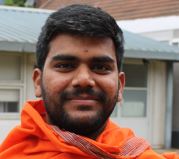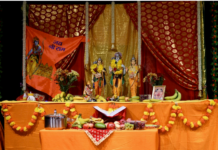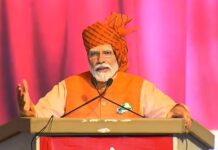 Krishna avatar was considered as a complete incarnation of the god. The name Krishna has several meanings so as he. Krishna means black/dark. Krishna means one who harvest. Krishna means one who attracts. Krishna means all-attractive, so black attracts light rather than reflecting it.
Krishna avatar was considered as a complete incarnation of the god. The name Krishna has several meanings so as he. Krishna means black/dark. Krishna means one who harvest. Krishna means one who attracts. Krishna means all-attractive, so black attracts light rather than reflecting it.
As everyone knows, Krishna has several different names. One among them is Yogeshwareshwara. Which means he is greater than any of the world’s finest yogis. Krishna stands holding a Murali (Flute) and cross his legs and the left leg completely touches the ground and the right only the toe touches. Also, if we observe there are 3 Bends in his body. As a result, this particular form of Krishna is a divinity emblem. Every God form has its own distinct style and significance. Devotees use all of these types for meditation as well.
The left part of the body represents material world (Prakriti) where as right part indicates spiritual reality (Purusha). The right leg is crossed over the left which means he stands firmly within the material world and uses this as a foundation to gain spiritual consciousness, since Krishna is incarnation of Vishnu (balance, sustenance and preservation) and hence balance. Many says whoever meditate and surrender to him they also experience the same consciousness as Krishna does.
In Kundalini Yoga, three bends signify the three Grandhis. A Yogi who breaks all three, Bhrama Grandhi, Vishnu Grandhi, and Rudra Grandhi, takes dominion of the Universe. As a result, this three-bent stance represents Krishna’s sovereignty over the three worlds, three forms of time (past, present, and future), three bodies (sthula, sukshma, kara), and three elements (sun, moon, and fire).
Krishna holds a flute in his hands and this flute has 6 holes, represents the 6 chakras (Muladhara, swadhisthana, Manipura, Anahata, Vishudha, Ajna) in our body. Above there is another hole representing the Sahasrara chakra (Krishna calls us from here). The lord is playing his flute, which activates the interior focused activities (pranakarma) that are blocking the chakras. The godhead (kutastha) is realized via the practise of pranakarma. The eye in the peacock feather signifies the godhead, which is why Lord Krishna wears it on his head. Lord Krishna’s peacock feathers on his crown are called as Sikhipincham in Sanskrit.
Why only peacock feather? Peacock is the only bird that does not have any physical attachment with Peahen. It observes full chastity without lust. In the same way though Lord Krishna had 16000 gopikas around him as his wives, he is still considered chaste as he did not have any lust towards them. It signifies his chastity and celibacy.
Followers of lord Krishna decorates him with yellow garment and yellow garland. Yellow always represents wisdom.
BG 15.15: I am seated in the hearts of all living beings, and from Me come memory, knowledge, as well as forgetfulness. I alone am to be known by all the Vedas, am the author of the Vedānt, and the knower of the meaning of the Vedas.
So, lord Krishna also called as “pitambar” means who wear yellow clothes.
Natvarasana or the Lord Krishna’s pose is a balancing pose that develops balance and concentration. In Sanskrit, Nata means dance and Asana means a yoga posture. Natvara is also a fond name of Lord Krishna. He is popularly depicted in this pose, playing the flute.
Benefits of Natvarasana (Lord Krishna’s Pose)
Natvarasana is a balancing pose. Practice this asana on both sides to develop balance on both sides.
Along with creating a sense of balance it increases concentration and awareness. During the practice, the mind should not wander. It improves steadiness and stability of the mind.
Natvarasana can be used as a preparation for meditation.
This is varnana of lord Krishna from bottom to top. I tried my level best to tell Krishna as greatest yogi of all the times where everyone thinks that he always with the gopikas.
He is not only a yogi but also the guru.
A yogi is anyone who is engaged in the practice of any form of yoga.
A guru is anyone who is qualified to teach; the qualifications required are 1) to be expert in the theory and practice of what he teaches, and 2) to be only interested in the benefit of the student(s).
He is the guru of all gurus, since he taught the Bhagavad Gita which is not only for Arjuna but also to the welfare of the world as his teachings are applicable for everyone, in a sense, the way to attain liberation (moksha). So, he has called as Jagadguru (Guru for entire universe).
BY: Anil Kumar

Readers like you, make ESHADOOT work possible. We need your support to deliver quality and positive news about India and Indian diaspora - and to keep it open for everyone. Your support is essential to continue our efforts. Every contribution, however big or small, is so valuable for our future.












Good explanation on Lord Krishna